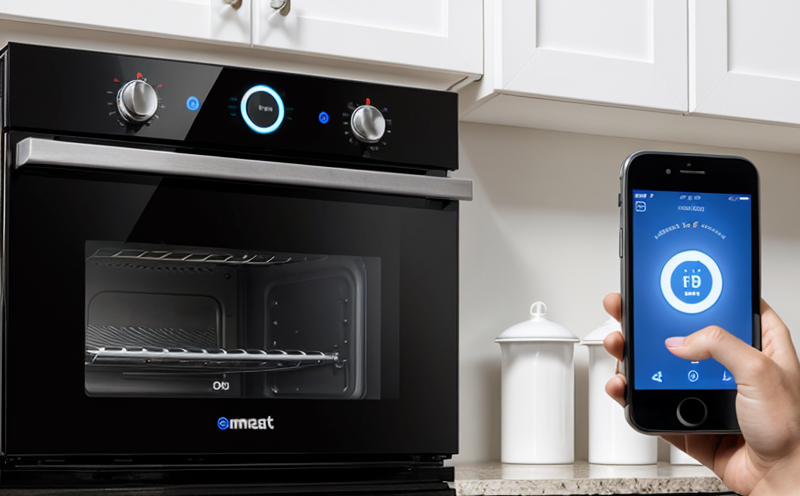UL 94 Flammability Testing of Smart Appliance Plastic Materials
The UL 94 flammability test is a critical standard used to assess the fire safety performance of plastic materials, particularly those used in consumer electronics and smart appliances. This test evaluates how quickly a sample ignites and how it extinguishes once the ignition source is removed. Understanding this behavior is crucial for ensuring that products meet stringent safety standards without compromising on functionality or design.
Smart appliances are increasingly integrating advanced technologies like Wi-Fi, Bluetooth, and voice recognition into everyday home devices such as refrigerators, washing machines, dishwashers, and even ovens. These advancements make them more convenient but also introduce new challenges regarding material safety. The UL 94 test specifically targets the plastic components of these smart appliances to ensure they do not pose a fire hazard.
The UL 94 standard is part of Underwriters Laboratories’ (UL) broader suite of testing and certification services aimed at enhancing product safety across various industries, including electronics, automotive, and consumer goods. By adhering to this test protocol, manufacturers can demonstrate compliance with regulatory requirements while also protecting their brand reputation.
The test involves exposing a small piece of the plastic material to an open flame for a specified duration and then measuring its self-extinguishing properties after removing the flame source. The results are categorized into different grades (e.g., V-0, V-1, V-2), each representing varying degrees of flammability resistance.
For smart appliances, especially those with exposed or easily accessible components, meeting these standards is not just a legal requirement but also an essential step in building consumer trust. Consumers expect their home devices to be safe and reliable, free from any potential fire risks that could arise due to inferior material choices.
In addition to ensuring compliance with regulatory bodies like the U.S. Consumer Product Safety Commission (CPSC), UL 94 testing helps manufacturers identify areas where they can improve product design and performance. By conducting thorough flammability tests early in the development process, companies can make necessary adjustments before launching their products into the market.
Furthermore, passing this test can significantly boost a company’s competitive advantage by differentiating it from competitors who may not prioritize safety or quality as stringently. A strong commitment to product safety can enhance brand image and foster long-term customer loyalty.
The UL 94 standard is widely recognized internationally and accepted across multiple jurisdictions, making it easier for manufacturers to export their products globally without facing additional barriers at borders. This global acceptance also facilitates smoother supply chains and broader market access, ultimately benefiting both the manufacturer and end consumers.
Why It Matters
The UL 94 flammability test is essential for several reasons:
- Consumer Safety: Ensuring that the plastics used in smart appliances do not catch fire easily helps protect consumers from potential hazards.
- Regulatory Compliance: Meeting this standard is often a requirement for selling products in certain regions, particularly those with strict fire safety regulations like North America.
- Brand Reputation: Demonstrating a commitment to product safety can enhance brand reputation and build consumer trust.
- Market Differentiation: Passing this test sets your company apart from competitors who may not prioritize flammability testing.
- Smoother Supply Chains: Compliance with international standards like UL 94 simplifies export processes and reduces the risk of product recalls.
By incorporating this test into their quality control procedures, manufacturers can ensure that their smart appliances meet or exceed safety expectations set by regulatory authorities and consumer demands.
Why Choose This Test
Selecting UL 94 flammability testing for your smart appliance plastic materials is a strategic decision that offers numerous benefits:
- Compliance Assurance: It ensures strict adherence to international standards, which can simplify regulatory compliance.
- Risk Mitigation: By identifying and addressing potential fire risks early in the development process, you minimize the likelihood of costly product recalls or lawsuits.
- Innovation Support: The rigorous nature of this test encourages continuous improvement in material science and engineering practices.
- Enhanced Credibility: Demonstrating a strong commitment to safety can significantly enhance your company’s credibility with both partners and customers.
These benefits translate into tangible advantages that contribute to the overall success of your product line. Choosing UL 94 flammability testing is not just about meeting basic standards; it's about setting a benchmark for excellence in fire safety within the smart appliance industry.
Competitive Advantage and Market Impact
The competitive landscape of the smart home and IoT device market is rapidly evolving, driven by technological innovation and consumer demand for safer products. In this environment, having a robust quality assurance process that includes UL 94 flammability testing can provide significant competitive advantages:
- Brand Differentiation: Products that meet or exceed safety standards like UL 94 are more likely to stand out in crowded markets, attracting discerning consumers who prioritize safety.
- Customer Trust: Consistent adherence to high-quality standards can build lasting relationships with customers and foster brand loyalty.
- Supply Chain Efficiency: Compliance with international standards simplifies logistics and reduces the risk of production disruptions due to non-compliance issues.
- Innovation Facilitation: The structured nature of UL 94 testing can inspire further innovation, encouraging manufacturers to explore safer materials and designs.
Moreover, by ensuring that your smart appliances meet these stringent safety criteria, you position yourself as a leader in the industry, capable of delivering cutting-edge technology without compromising on essential safety features. This leadership role not only enhances market impact but also opens up new opportunities for growth and expansion.





